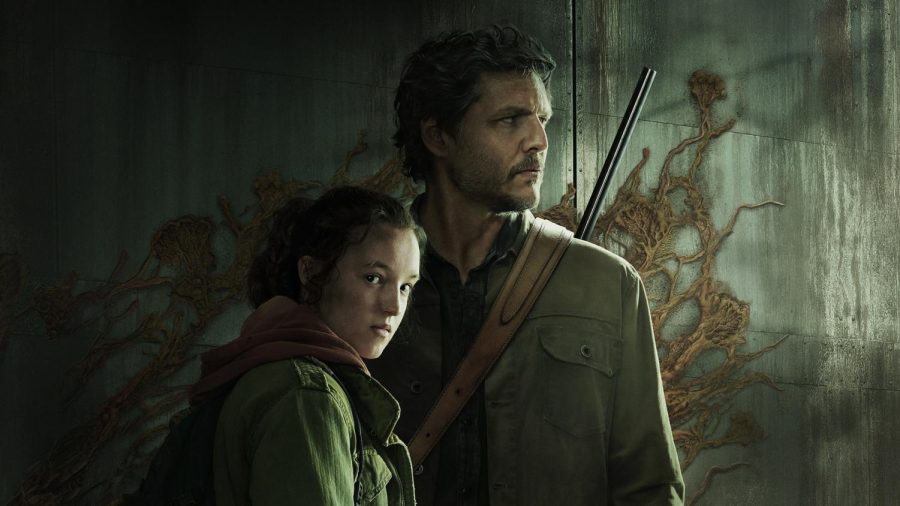TV Review: “The Last of Us”
HBO’s “The Last of Us” adapted the 2013 game into a 9-episode television series. The show stars Pedro Pascal as Joel Miller and Bella Ramsey as Ellie.
March 22, 2023
Shows like “The Walking Dead” and “Station Eleven” have depicted pandemic-related storylines for many years and have been growing in popularity especially since the COVID-19 outbreak in 2019. Ten years after the release of the highly renowned video game “The Last of Us”, a dystopian story about a world-wide infection, HBO Max released nine episodes of the new adaptation starting on Jan. 15 of this year. The finale of the very well received and highly appreciated show aired on Sunday, March 12.
If you have not watched the show yet, I would recommend finishing before reading, as this will be quite the opposite of a spoiler-free review.
The “Last of Us” follows Joel Miller (Pedro Pascal) twenty years after the initial outbreak in 2003. After losing his daughter, Sarah (Nico Parker), on one of the first days of the outbreak, Joel finds himself helping with the disposal of bodies that were recently infected and executed in consequence. After meeting Ellie (Bella Ramsey) and learning she may be immune, they set out on an expedition to make a vaccine with none-other than Ellie herself.
The remaining eight episodes follow Ellie and Joel and their journey across the country. Death, injury and the near deaths of each Ellie and Joel occur throughout this time, as well as various flashbacks and connections with other characters along the way. With each episode that progresses, the two main characters find themselves becoming closer despite their unwillingness to let people in and experiences with losing loved-ones in the past.
“Cordyceps” are the cause of the infection in “The Last of Us”, and the intricacies of the world-building after this large onset of zombie-like behavior points to the large amounts of effort put into the plots of both the game and the subsequent adaptation. Unlike other zombie-related television, people who are infected in “The Last of Us” are fully aware of what they are doing and who they are infecting, but unable to control their physical actions due to the cordyceps infecting their brain and ability to control their own bodies.
This level of consciousness in infected individuals impacts the emotional toll on audiences when considering the lack of control their potential favorite side characters have when they are bitten, infected and then consequently killed by a surrounding person. A death that specifically hit audiences rather hard was the death of Sam, a young boy with hearing loss that Ellie tried to save after he turned and tried to kill her. The overall theme of this show is don’t get attached (to anyone)!
Ellie’s past is covered in the show’s seventh episode, a heart-wrenching and absolutely devastating portrayal of her best friend Riley and her presumed unfortunate end. The two girls, after being separated for three weeks, come together for “one last night” in the form of exploring an abandoned mall. Riley had decided to join the “fireflies,” an opposing militia group revolting against the government FEDRA in the quarantine zones.
Throughout their last hours together, Ellie and Riley start to both realize they may have something more than just a friendship; Ellie, usually a headstrong and stubborn character, is rather bubbly and soft with Riley. The show and actresses do a great job at depicting the multiple layers of this connection–young adoration, unknown sexualities and the added layer of an ongoing and deadly pandemic surrounding it all.
Moments after finally convincing Riley to stay with her and escape to somewhere else, Ellie has to fight off an especially violent infected and they both get bitten in the process. What ensues is the subsequent rage of the event and what the audience can only assume is a tragic departure of the two young lovers just hours after their first and only romantic connection. If you find yourself crying easily at tv shows, be sure to bring the tissues; you will need them from the first episode onward.
Ellie and Joel’s connection throughout the nine hour-long episodes gets stronger with each scene, mostly because of the amount of the shared anguish they have to experience together. As each episode progresses, Ellie becomes more and more like a daughter to Joel, filling the empty space that was made twenty years prior.
It is discovered in the last episode that Ellie’s immunity was caused by her mother being bitten before she had cut the umbilical cord while giving birth to her. Her mother, Anna, was actually played by the actress who played Ellie in the video game (Ashley Johnson), which adds a level of appreciation for lovers of the game.
This first season ends with Joel and Ellie reaching the hospital where Ellie is to be tested to attempt to create a vaccine. Little do both of them know, however, that Ellie’s brain needs to be surgically taken apart to gather the cordyceps that make her immune. Joel, unwilling to sacrifice his newfound daughter-figure for a cure, kills everyone in the vicinity before they can make the first slice.
Audience members and players of the game have been debating this scene for the last decade: did Joel make the right decision? When given the opportunity to potentially save the world, Joel saved his own–Ellie.
Through phenomenal casting, acting, cinematography and shots that are side-by-side exactly accurate to the game, the producers and directors of “The Last of Us” created a beautiful, heart breaking and terrifying portrayal of the dystopian world many people were already familiar with. Bella Ramsey and Pedro Pascal have been said to be the perfect people to play the loved and renowned Ellie and Joel, and their friendship on and off screen only add to that sentiment.
Watch “The Last of Us” on HBO Max.



































